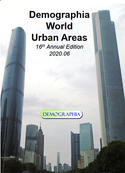This may come as a surprise, but bicycles provide more 30-minute job access than transit for the average worker in 50 large metropolitan areas (combined). This is evident from data produced by the University of Minnesota Accessibility Laboratory. The 50 metropolitan areas all have more than 1,000,000 population, though do not include Memphis, Grand Rapids or Tucson, the three others of that size. Reports have been produced for job access, by travel time for the average worker in the metropolitan areas. read more »
New York
Bicycles: A Refuge for Transit Commuters?
- Login to post comments
The Twilight of Great American Cities is Here. Can We Stop It?
The dreadful death of George Floyd lit a fire that threatens to burn down America’s cities. Already losing population before the pandemic, our major urban centers have provided ideal kindling for conflagration with massive unemployment, closed businesses and already rising crime rates. read more »
- Login to post comments
COVID Work Trip Reduction Estimates: CSAs with Transit Legacy Cities
America’s elite central business districts have symbolized the ascendency of big cities, epitomized by soaring office towers. But today, due the COVID-19 pandemic, so much office work performed in these CBDs can be done remotely, that their future seems far less towering than in the past. In contrast, less dense areas, notably exurbs, appear to have suffered less loss in their employment patterns. read more »
- Login to post comments
America's Long Suffering Rail Commuters
The long, streaking commuter trains (suburban rail) carrying workers mostly into and out of downtown every day may give the impression of “rapid transit.” However, regardless of the top speeds they reach, the average suburban rail rider spends far more time traveling to work than those using other modes of getting to work (Figure 1). They spend far longer than the majority of commuters, who drive alone. Even in the New York combined statistical area (CSA), with the largest suburban rail network a majority drive to work (Figure 2). read more »
Perspective: U. S. COVID-19 Deaths and Urban Population Density
There is wide consensus that the COVID-19 virus spreads person-to-person, especially in confined spaces that are insufficiently ventilated. It is exacerbated by prolonged proximity, which John Brooks, the Centers for Disease Control and Prevention’s chief medical officer indicates is 15 minutes or more of unprotected contact with someone less than 6 feet away. read more »
- Login to post comments
Storied Cities
Athens is the birthplace of Western culture, with the physical ruins of its classical age still visibly present as a perpetual reminder. Virgil composed his epic poem, The Aeneid, recounting the mythic flight of Aeneas from defeated Troy to Italy, becoming the forbear of Rome. New York sees itself as unique center of commerce, founded when the Dutch (not the English) bought Manhattan for beads in the city’s first hustle. Nashville needs no reminder that it’s the center of country music, nor Detroit that it is the Motor City. read more »
- Login to post comments
Demographia World Urban Areas, 2020: Tokyo Lead Diminishing
For the first time in more than six decades the world’s second ranked built-up urban area has reached within 10% of leader Tokyo. The 2020 edition of Demographia World Urban Areas reports that Jakarta has reached a population of 34.5 million, behind Tokyo-Yokohama’s 38.0 million (Figure 1). The report can be downloaded here (Note 1). read more »
- Login to post comments
The Urban Project: Urbanization, Urbanisms, and the Virus – A Historical Take
Observing and writing 20-some years before the oil embargo (1974) and 30 years before the stern Brundtland report (1987), Jane Jacobs (1961) resolved that density comes in “good” and “bad” varieties. read more »
- Login to post comments
From tragedy to opportunity: We could live better when today's mayhem ends
For most people in this locked-down, riot-scarred world, the future beckons unpleasantly. There is a growing sense that, economically, the 2020s may look more like the 1930s than some halcyon post-industrial future. “Dark days ahead,” suggests The Week. “This is what the end of the end of history looks like." read more »
- Login to post comments
Economy Loses Jobs Equal to Metro New York, Los Angeles, Chicago, and DFW
The economic distress resulting from the COVID-19 pandemic and strategies to limit its spread have been substantial. The most intense effects have been inflicted on the estimated 26 million workers who have lost their jobs, either temporarily or permanently. Many businesses may not be able to recover, while others may never be restored to their previous employment, as customer revenues take years to recover. read more »
- Login to post comments






















